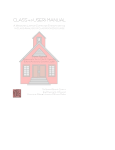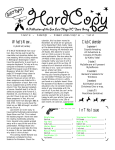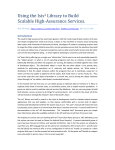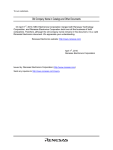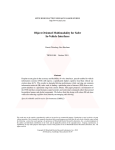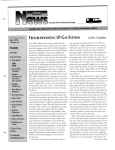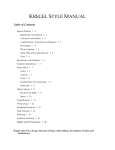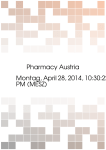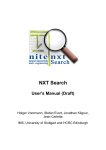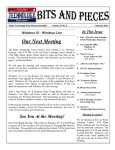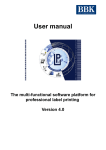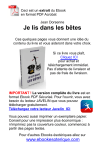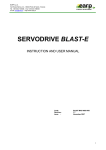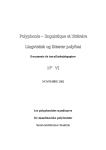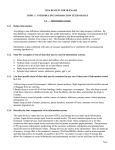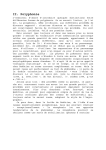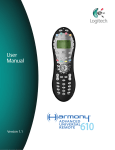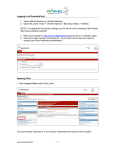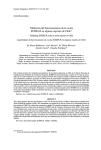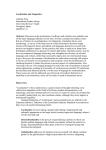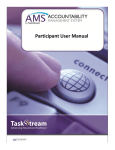Download CLASS 4.0 USER`s MANUAL - Center for Research on Dialogic
Transcript
CLASS 4.0 USER's MANUAL
A WINDOWS LAPTOP-COMPUTER SYSTEM FOR THE
IN-CLASS ANALYSIS OF CLASSROOM DISCOURSE
Martin Nystrand
Programming by Craig Weinhold, Yen-Ju Chen, & Yunpeng Pan
Editorial Assistance by Samantha Caughlan
Automating the Measurement and Assessment of Classroom Discourse {
University of Wisconsin-Madison
This program and documentation were prepared at the University of Wisconsin at
Madison’s Wisconsin Center for Education Research (WCER). The Center is supported
by the U. S. Department of Education's Office of Educational Research and Improvement
(Award # R305A60005). However, the views expressed herein are those of the author(s)
and do not necessarily represent the views of the department. For more information about
the program, contact Martin Nystrand, CELA Director: [email protected].
Classroom Discourse Is . . .
•
The language of learning (Courtney Cazden)
•
The ocean on which all else floats (James Britton)
Talking to Learn Is . . .
•
A struggle to organize . . . thoughts and feelings, to come up with words that . . .
shape an understanding (James Britton)
Introduction
4
is a Windows laptop-computer program for the in-class
analysis of classroom discourse. The unit of analysis in this
program is the question, and to operate CLASS 4.0, the classroom
observer types in and codes each nonprocedural question that
teachers and their students ask during the course of a class
period. Procedural questions, e.g., questions about pages to be
read as homework, are not included in this analysis since they are
peripheral to instruction and learning.
Questions, of course, presume answers, and question-answer
exchanges dominate classroom interactions in English Language
Arts instruction. Hence, for purposes of analysis, the questions
teachers and their students ask during a class period effectively
index the entire discussion, and we may build profiles of
instruction and study classroom discourse by focusing on the
questions.
In using CLASS 4, the observer is prompted to code each
question for (a) source (who asks the question: teacher or
student), (b) response (whether there was a response), (c)
authenticity (authentic questions are questions for which the
teacher has not prespecified an answer), (d) uptake (uptake
occurs when a teacher incorporates a previous student answer
in a subsequent question), and (e) cognitive level (report or high
level: generalization/analysis).
Unlike previous versions of CLASS, CLASS 4.0 codes responses
to questions for (a) respondent’s identity, (b) extent of elaboration, (c) audience for the response (teacher or class), and (d)
relation of response to other responses.
Because of the importance of student questions (Nystrand,
Wu, Gamoran, Zeiser, & Long, D. [2001]), CLASS 4.0 also
prompts the observer to code the teacher’s response to student
questions, checking whether the teacher uses the question to
open up discussion or manages it in such a way as to table it.
During seatwork, lecture, reading aloud, small group work,
and question-answer activities, CLASS 4.0 prompts the observer
CLASS
Introduction
i
periodically to indicate the number of students who are obviously offtask, plus any appropriate adjustments in the number of
students in the class (in case any have recently entered or left the
classroom). The program also elicits miscellaneous holistic
assessments of instruction and curriculum after each observation.
When data collection is completed, the observer can use the
program to proofread, edit, and revise the file for incomplete
and inappropriate codings and compute basic statistics for each
episode and class.
CLASS 4.0 is premised on a view of instruction not as what
teachers provide or do to students but rather as what teachers
and students collaboratively negotiate.
High-quality classroom
discourse is characterized by substantive reciprocity between
teachers and their students. In such instruction, students and
not just teachers have a lot of input into the business of the
classroom and hence what is learned.
CLASS 4.0 provides a
number of measures designed to assess the quality of interaction
between teachers and their students. A fuller discussion of this
view of instruction as discourse is presented in Nystrand (1997),
Applebee (1996), and Langer (1995).
The linkage of human to human is, in the final analysis, the groundwork of all
ethics as a reflection on the legitimacy of the presence of others. H. R. Maturana
& F. J. Varela
The bottom line for instruction is that the quality of student learning is closely
linked to the quality of classroom talk. Martin Nystrand
§1. Rules for Classifying & Coding Classroom
Discourse
§1.1. Discourse Episodes and Segments
An episode is a coherent classroom activity centering around a
particular purpose or topic.
A new episode starts when the
teacher addresses a new purpose or topic. High school lessons
typically begin and end with procedural episodes “Getting
started” and “Preparing to leave.” Between these episodes, we
typically find one or more instructional episodes, which often
consist of two or more activities. For example, in teaching a
lesson on Roll of Thunder, Hear My Cry, a teacher may begin by
reviewing the previous night’s reading assignment in a questionand-answer session, which develops into an open discussion or
leads to smallgroup work, which culminates in in-class writing as
students write their reactions to the exchange of views during
discussion; the teacher views this writing as a head start of that
night’s homework assignment, which is to read the next chapter.
CLASS treats sequences of activities like this as a series of segments comprising an instructional episode.
The episodic
structure for the lesson just mentioned is:
Episode 1: Getting started
Episode 2: Roll of Thunder, Hear My Cry
Segment 1: Q/A
Segment 2: Discussion
Segment 3: Seatwork/monitoring
Episode 3: Preparing to leave
An activity is defined by how it develops or is realized. If a
teacher’s planned review turns into a discussion, it is to be coded
as a Q/A segment followed by a discussion segment, even if the
teacher planned only a review. Similarly, if students are doing
silent reading start writing answers to homework questions
2
CLASS 4.0 CODING RULES
about the reading, it is to be coded as a silent reading segment
followed by a seatwork segment. Two rules:
•
•
Activities are defined by how they are enacted.
If some students are engaged in one activity, e.g., silent
reading, and others are doing something else, answering
homework questions, code the activity which most of the
students are doing.
§1.2. Approach to Question Coding
CLASS question coding treats questions as sites of interaction. As Heritage & Roth (1995) and Schegloff (1984) contend,
the character of any unit of discourse and related interaction is
a function of the participants’ understanding.
Following this
principle, you are to code not questions per se but rather the
participants’ understandings of their interactions as manifest by
their discourse moves. To judge the authenticity of a question,
for example, requires that you take your cues not only from how
students answered the questions, but also how the teacher
responded to the students’ answers.
As with authenticity,
cognitive level is to be coded according to the level of cognitive
functioning the question elicited, not the question by itself. In
all cases, code not the questions directly but rather the character
of social interaction involving, valorized, and elicited by the
questions.
§1.3. Questions Not To Code
§1.3.1. Rhetorical Questions. Be alert to rhetorical questions.
They are not to be rated (not even recorded).
§1.3.2. Procedural Questions.
Questions like "Does that
answer your question?" and "Do you have any questions?" are
procedural, not substantive and should not be included in your
list of coded questions.
RULES OF CODING
3
§1.3.3. Discourse-Management Questions. Questions like
(a) "What?", "Did we talk about that?", or "Where are we [in the text]?", which
manage classroom discourse, and (b) "Do you remember our discussion
from yesterday?", which initiate discourse topics, should not be
coded.
§1.4. Aborted and Repaired Questions
A question-and-answer sequence is a negotiation of sorts.
In
asking a question, a conversant in effect enters (or sustains) a
negotiation with conversants, and the question posed must work
in terms of the knowledge, experience, and expectations of the
other conversants, i.e., it must initiate or sustain a shared balance
of discourse (Nystrand, 1986).
If teachers ask questions that
elicit no answer, this is an aborted question; click ‘N’ (No) when
prompted for RESPONSE (Y*/N: the asterisk indicates that Y
is the default; simply pressing <ENTER>). Note that an aborted
question is different from a repaired question, which is a question
the teacher asks and, without giving students a chance to answer,
revises. When someone repairs a question, you need only record
the final version of the question.
The proportion of teacher questions that fails to elicit an
answer is an index of the extent to which the teacher incorrectly
anticipates the capabilities and knowledge of the class. If the
teacher asks too many questions that students are unable to
answer or don’t know how to answer, it means that the teacher
has misjudged the students in some fundamental way; the
question indexes a mismatch.§2.5. Authentic vs. Test Questions
Learning is often built on surprises. Robert Gundlach
§1.5.1. Authentic Questions are questions whose answers are
not prespecified by the teacher. By contrast, an inauthentic question, sometimes called a test question, allows students no control
4
CLASS 4.0 CODING RULES
over the flow of the discussion, and an authentic question allows
the student substantial input, if not control over, the flow of the
discussion.
§1.5.2. “What Else?” Code the question "What else?" as:
•
•
Inauthentic (test) when it is used for negative evaluation, i.e.,
when a student gives a wrong answer and the teacher
continues to look for the correct one by saying, "What else?";
or
Authentic when used during brainstorming, i.e., when any
answer is satisfactory.
§1.6. Uptake
Uptake is the speaker’s incorporation of a previous answer into
a subsequent question (Collins, 1982). It is often marked by the
use of pronouns:
C
C
C
How did it work?
What causes this?
What city grew out of this?
In such questions, the pronoun (technically a deictic reference)
refers to a previous response.
To qualify as uptake, a question must incorporate a previous
answer, not a previous question. Normally, this incorporation of a
previous answer will involve actual quoting. Questions that are
repeated do not qualify as uptake.
Less obvious deictics include:
th e n : e.g., "And then what happened?" Here then means "after that,"
i.e., "after what you just said."
s o : e.g., "So which value was given to them?" Here so means "Given
that," i.e., "Given what you just said, which value was given to them?"
m ay b e : e.g., "Maybe. What do you think?" where maybe should be
read maybe so.
RULES OF CODING
5
th o u g h : e.g., "Per item though?" where teacher follows up a
student response to get a more specific answer (previous
question was "Which has higher overhead?"): though here means
"despite or beyond what you said."
§1.6.1. Uptake by Ellipsis.
Uptake may be characterized by
ellipsis. For example, if, when a teacher asks a question and a
student answers, the teacher then asks "Why?", the "Why?" is to be
scored positive for uptake; "Why?" incorporates the previous
student answer by ellipsis. "Because . . .?” as a follow up question
works the same way.
§1.6.2. Missing Uptake.
In the following sequence, there is
no uptake:
Teacher question:
Student response:
Teacher question:
What’s the first x?
...
What’s the second x?
There is no uptake here because the teacher does not incorporate a student’s answer into a subsequent question.
§1.6.3. Types of Uptake.
Uptake will either be faux (test)
uptake or authentic uptake.
•
Authentic uptake: Teacher asks an unprescripted question
about a student response.
•
Test (faux) uptake:
(a) Teacher incorporates previous answer into an ongoing
script. E.g.,
Teacher: What’s the subject of the sentence?
Student: “Rabbit”
Teacher: And the rabbit did what?
6
CLASS 4.0 CODING RULES
In this exchange, the teacher follows up on the student’s
answer (“rabbit”), but the answer was entirely predictable.
(b) Teacher follows up a student answer to check (test) the
student’s understanding
§1.7. Cognitive Level
§1.7.1. Reporting vs. Thinking.
We distinguish two levels of
cognition:
R* Recitations and reports: What happened? Don’t correspond
to screen prompts (default)
H High-level generalization or analysis, i.e., thinking: What
happens? and Why?
As a general rule of thumb, lower-order questions (i.e., questions
eliciting reports) result in answers that are known information
whereas higher-order questions (i.e., questions eliciting generalizations, analyses, or speculations) result in answers that are new
information.
Like authenticity, the cognitive level of questions cannot be
judged altogether from words alone. In judging cognitive level,
code the level of cognitive functioning that the question seeks
to elicit, not the question by itself or its linguistic structure.
Cognitive functioning is high to the extent that "the question
cannot be answered through the routine application of prior
knowledge" (Newmann, 1988). In Polanyi’s (1962) terms, lowlevel cognitive functioning is a routine performance whereas
high-level cognitive functioning is a heuristic act. Hence, though
a why-question will ostensibly elicit an analysis, it will elicit a
report if the teacher’s focus is the recitation of a textbook's
analysis rather than the class’s reflection, In such a situation,
“Why?” really means, “According to your text, why did it
happen this way? Do you remember?”
RULES OF CODING
7
§1.7.2. Generalization/Analysis.
Generalization is the
derivation or induction of a general conception or principle
from particulars, typically in response to an open-ended question. Analysis is the determination of the nature and relationship
r of parts in a whole entailing two or more stipulated particulars
or concepts a, b. In analysis the teacher typically stipulates terms
for consideration (e.g., "Given what we’ve just said, given a and b, etc., what’s
the author’s point?") whereas in generalization the teacher does not
stipulate terms for consideration; the students do (e.g., "What’s the
point?").
Examples of generalization: What happens when you get to the next
stanza? Who are these people? What do you think is the message? What does it mean
to be in shackles? What does a tornado do? What’s the author saying here? What’s
it all about? Contrastive example of generalization and analysis:
TEACHER:
STUDENT:
TEACHER:
What did Robert Fulton do? What was the result? How did
his success affect river travel? What’s a problem that some rivers
have?
...
So how did Fulton’s success affect river travel?
In the first question, which is a multiply repaired question, the
teacher is working to stipulate the terms of an analysis he wants
students to do. The question, "What’s a problem some rivers have?" is
meant to elicit a generalization in preparation for a particular
analysis these questions are driving towards: "So how did
Fulton’s success affect river travel?"
§1.7.3. Factors Affecting Cognitive Level.
The cognitive
level of any question is affected by: (a) the knowledgeability of
the person answering the question, (b) nature of the instructional activity, and (c) the source of information required by the
question.
(a) Knowledgeability of the person answering of the question. Questions are to be coded as reports when their answers elicit a routine
cognitive operation. But note that "routine" varies depending on
what the person answering the question knows: The very same
8
CLASS 4.0 CODING RULES
question that elicits an analysis from one person may well elicit a
report from another, more knowledgeable individual.
This
distinction is especially germane to teacher or student questions.
For example, "How did the French regain control of Canada?" may
well elicit an analysis from students (assuming, of course, that they
have to figure out the answer and not merely recite their textbook
account on the point), but it will elicit a report if a student asks the
teacher, who already knows the answer. Of course, teachers may
not have the answers to all student questions at their fingertips, and
if the teacher clearly thinks about a challenging student question,
as indicated by a pregnant pause, for example, the question is to be
considered as an instance of generalization or analysis. Nonetheless, most student questions addressed to teachers will elicit
reports. In some low-ability classes, spelling or even pronouncing
new and difficult words will require analysis whereas in other
classes, where students have already mastered the pronunciations
and spellings of the same words, their spelling is a mere, routine
report.
(b) Nature of the instructional activity. When whole-class instruction is
devoted to review, the normal expectation for the cognitive level
of the questions is report, even if the questions have the linguistic
form of higher level questions.
Sometimes, of course, you may
encounter teachers who use review as a basis for analysis and
reflection, so take this situation into account in your coding.
(c) Source of information required by the question. We define "prior
knowledge" as "prior to the previous night’s homework." Hence,
if a teacher asks students about the previous night’s reading, the
question will normally elicit a report.
§1.8. Coding Ambiguous Questions
§1.8.1. Preformulated Questions (e.g., "Do you think that’s important?"). In judging cognitive level of preformulated questions,
disregard the preformulator ("Do you think. . ."), and code the
remainder of the question ("Is it important?"), i.e., code only the
nuclear utterance (cf. French and Maclure, 1981). Superficially
a question such as "Do you think that’s important?" elicits a record (i.e.,
what the student is thinking now), but if the real purpose of the
RULES OF CODING
9
question is to elicit a higher cognitive operation (an analysis of
what is important), it should be so coded. Hence:
"Do you think that’s important?"="Is that important?"=ANALYSIS
"Do you know what a catechism is?"="What is a catechism?"= REPORT
"Do you understand why #11 is a ‘b’?"="Why is #11 a ‘b?’= ANALYSIS
"What do I mean by ‘transition’?"="What’s a transition?"=REPORT or
ANALYSIS, depending on context student to report. When in
doubt about cognitive level, always ask what mental operation the
question is eliciting (not the literal meaning of the question).
Hence, "Should I do anything more with it?" should be coded as
"What more should I do with it?"
§1.8.2. Homework Questions.
Sometimes teachers will ask
questions about things students have already completed or
considered, e.g., homework.
If, in answering these questions,
students actually consult their homework, the question will elicit
a report, since the students are reporting on what they have
already done.
If the students do not actually consult their
homework, however, the questions should probably be coded as
if they had been asked the first time, i.e., analysis/generalization.
When teachers ask questions about what students are thinking (and not just to
see if they have done their homework), and when they ask them questions about
their previous answers, they promote fundamental expectations for learning by
seriously treating students as thinkers, i.e., by indicating that what students think
is important and worth examining (Martin Nystrand)
§1.8.3. Redirected Questions.
Whenever a teacher redirects
a question to another member of the class, code the new
question with the same values as the original question; use DITTO
This includes uptake, authenticity, and cognitive level.
For
example:
Eugene, can you tell me a bit about it?
Mike?
T A Report
T A Report
.
10
CLASS 4.0 CODING RULES
§1.9. Coding Responses to Questions
Meaning is realized only in the process of active, responsive understanding.... Only the
current of verbal intercourse endows a word with the light of meaning. Valentin Vološinov
§1.9.1. Principal Codings
•
•
Relation to other responses. One part of multiple response
(y/n). When teachers encourage or allow multiple responses
to a single question without repeating the question, it can
indicate a transition to dialogic interaction in the class.
Identity of respondent. In the text box next to this prompt,
type in a code identifying the respondent.
§1.9.2. Teacher Evaluation/Followup: Elaborated vs unelaborated.
Elaborated responses show thinking and offer a
rationale for the answer given (two parts: answer + elaboration).
Unelaborated responses provide just answers, typically with just
the information the question targets.
§1.9.3. Teacher Response to Student Questions
Coding teacher response to student questions.
Whenever a
student asks a question, you will be prompted to code the nature
of the teacher’s response: T response (C/A*/O) where
C = Closing down: Tabling , changing the subject (perhaps with
a different question)
A = Answering (default), either elaborated or unelaborated
O = Opening up: Asking for more information, rerouting
question to class.
§1.10. Classifying Instructional Activities
RULES OF CODING
11
§1.10.1. Lecture.
Lecture is to count as a segment only when
the teacher talks uninterrupted for at least 30 seconds.
Lecture, film, video, music also refers to student consumption of recorded material, such as documentaries, fiction films
or books on tape.
Lecture deals with English content, not with instructions for
class activities. Code as Lecture when teacher is talking about
skills or knowledge which will be generally useful to the student
in the future. For example, “How to do a bibliography” may
be Lecture, but “You may only have one Internet source in your
bibliography for this paper” would be Procedures and Directions.
§1.10.2. Discussion.
We define discusMs. Lindsay’s class was
sion as free exchange of information
about figuring things
out—in class, face-to-face,
among students and/or between at least
teacher and students
3 participants that lasts longer than 30
together.
seconds. The 3 participants may include
Opening Dialogue, p.
the teacher, though the teacher may be
2
deliberately silent during some
discussions.
When discussion occurs in
the midst of question-and-answer, it
interrupts or violates the normal initiation-response-evaluation
sequence of recitation. Discussions typically include relatively
few questions; most often these questions clarify ideas and
information ("By that do you mean . . . ?") and are consequently
authentic since, rather than quizzing each other, the conversants
exchange only that information they actually need to know.
Discussion displays regular uptake so long as the conversants
listen and respond appropriately to each other. Typically
discussion comes about in question-answer when a student
volunteers an observation (not a question) that substitutes for
teacher evaluation.
§1.10.3. Student Presentation: Quick vs Careful
12
•
•
CLASS 4.0 CODING RULES
Quick: Students have only the class hour or less to prepare.
Careful: Students have prepared at home or during previous
class sessions, and it is clear that this counts as more than
a daily grade.
§1.10.4. Reading Aloud
generally refers to students reading
aloud. Teachers reading aloud an excerpt to illustrate a lecture
point counts as lecture; however, teachers taking their “turn” in
the reading aloud of a class text counts as Reading Aloud. Tapes
of someone reading aloud count as “lecture, film, video, music.”
§1.10.5. Role Play or Simulation:
An open-ended activity
where students take on a role or put themselves in another’s
place. Example: The class having a “town meeting” of characters in a story, or choosing lots before reading “The Lottery.”
Sitting in seats and reading parts from a play is reading aloud.
Students preparing and then presenting a scene can be either
Student Presentation or Role Play, depending on how faithful
they are to the class text.
§1.10.6. Game:
A structured activity with rules, points,
winners, losers. Examples: Pictionary, Vocabulary BINGO.
§1.10.7. Class Interruption:
An interruption originating
outside the class interrupts class activity.
Examples: intercom
announcements, visitor, CELA paperwork.
§1.10.8. Seatwork.
Seatwork is coded according to Source,
Cognitive Level (see above, question coding), and Who organizes the product, as well as Type of writing, if any.
§1.10.8.1. Writing Without Composing: all mechanical
uses of writing:
C Multiple-choice exercises
RULES OF CODING
13
C Fill-in-the blank exercises (answered with less than a
sentence)
C Short-answer exercises (brief, one or two sentences per
question)
C Writing to show memorization (e.g., science or math
calculations, spelling tests, written recitation)
C Transcription from either written material (copying) or
(dictation)
C Translation (copying words or short phrases from one
language into another)
C Other mechanical uses (diagraming, vocabulary exercises,
crossword puzzles, pre-first draft activities, e.g., concept
mapping)
§1.10.8.2. Composing:
writing that is informational,
personal or imaginative.
§1.10.9. Small Group Work.
Small group work is to be
coded for the following:
C Teacher-structured group work (i.e., collaborative seatwork).
Task parameters entirely defined by teacher.
Task can be
done without student interaction (e.g., worksheets); group
setting is gratuitous.
C Prescripted task: Prescripted task with obligatory student
interaction.
C Limited student interaction: Teacher gives students some
latitude in their interactions with each other, and group work
involves spontaneous student interaction concerning substance; students are on “short leash.”
For example, the
teacher might define some general principle which students in
groups must then apply.
C Significant student interaction: Significant student interaction,
including discussion, defining shape of task and outcome
though teacher might have been able to predict results before
class.
14
CLASS 4.0 CODING RULES
C Autonomous group work: Teacher sets up group work
without prescripting activities; significant student interaction,
including discussion, defining shape of task and outcome.
Results of group work cannot be predicted before class.
§1.10.10. Offtask.
See pp. 14, 15.
§1.10.11. Discipline.
We distinguish between admonitions, for
example, asking some students to pay attention (“Helen, pay
attention”), and discipline, when the teacher brings a halt to
things (“Alright, that’s it!”) to straighten out a more serious
problem. When the teacher seems to be dealing with a nuisance,
it’s an admonition; when the teacher shifts gears to address a
problem, it’s discipline. CLASS is to be used only for noting
discipline.
§1.10.12. Shifting Numbers of Students.
Sometimes
students will enter and leave the class during the period. When
the number of students changes, indicate this number when so
prompted by the OFFTASK routine.
§1.10.13. Ambiguous Activities.
When the teacher does one
thing (e.g., lecture) and students are allowed to do another (e.g.,
seatwork), classify the activity most students do.
References
Applebee, A. N. (1981). Writing in the secondary school. Urbana:
National Council of Teachers of English.
––––––. (1996). Curriculum as conversation: Transforming traditions of teaching
and learning. Chicago: University of Chicago Press.
Britton, J., Burgess, A., Martin, N., McLeod, A., & Rosen, H. J.
(1975). The development of writing abilities: 11-18. London: MacMillan.
Collins, J. (1982). Discourse style, classroom interaction and
differential treatment. Journal of Reading Behavior, 14, 429-437.
French, P. and Maclure, M. (1981). Teachers’ questions, pupils’
answers: An investigation of questions and answers in the
infant classroom. First Language, 2, 31-45.
Langer, J. (1995). Envisioning literature: Literacy understanding and literature
Instruction. New York: Teachers College Press.
Moffett, J. (1968). Teaching the universe of discourse. Boston: Houghton
Mifflin.
Newmann, F. (1988). Can depth replace coverage in the high
school curriculum? Phi Delta Kappan, January, 345-348.
Nystrand, M. (1986). The structure of written communication: Studies in
reciprocity between writers and readers. Orlando and London: Academic Press.
––––––. (1997). Opening dialogue: Understanding the dynamics of language and
learning in the English classroom. Martin Nystrand with Adam
Gamoran, Robert Kachur, and Catherine Prendergast. New
York: Teachers College Press.
––––––, Wu, L., Gamoran, A., Zeiser, S., & Long, D.(2003,
March-April). Questions in Time: Investigating the Structure
and Dynamics of Unfolding Classroom Discourse. Discourse
Processes, 35, 135-196.
Polanyi, M. (1962). Personal knowledge. London: Routledge & Kegan
Paul.



















